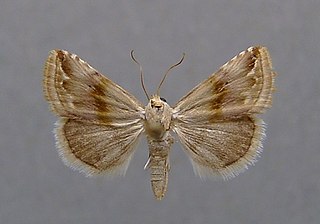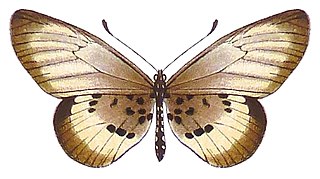
The common footman is a moth of the family Erebidae. The species was first described by Johann Leopold Theodor Friedrich Zincken in 1817. It is distributed throughout Europe and east through the Palearctic to Lake Baikal.

Junonia hierta, the yellow pansy, is a species of nymphalid butterfly found in the Palaeotropics. It is usually seen in open scrub and grassland habitats.

Ematurga atomaria, the common heath, is a moth of the family Geometridae.

Wittia sororcula, the orange footman, is a moth of the family Erebidae. The species was first described by Johann Siegfried Hufnagel in 1766. It is found in Europe, Anatolia and further east across the Palearctic to southern Siberia and the Amur basin to China.

Calliteara pudibunda, the pale tussock, is a moth of the family Erebidae. The Dutch common name for the moth (Meriansborstel) comes from the butterfly and insect painter Maria Sibylla Merian. The species was first described by Carl Linnaeus in his 1758 10th edition of Systema Naturae. It is found in Asia and Europe.

Trabala vishnou, the rose-myrtle lappet moth, is a moth of the family Lasiocampidae. It is found in southern Asia, including Pakistan, India, Bangladesh, Thailand, Sri Lanka, Myanmar, Java, China, Japan, Taiwan, Hong Kong, Vietnam and Indonesia. Four subspecies are recognized.

Nycteola revayana, the oak nycteoline, is a moth of the family Nolidae. The species was first described by Giovanni Antonio Scopoli in 1772. It is found from Europe and east across the Palearctic to Japan and India.

Eublemma ostrina, the purple marbled, is a moth of the family Erebidae. The species was first described by Jacob Hübner in 1808. It is mainly found in central and southern Europe, and further east, but is also a scarce migrant in the United Kingdom, where it is mainly found along the south coast.

Papilio androgeus, the Androgeus swallowtail, queen page, or queen swallowtail, is a Neotropical butterfly of the family Papilionidae. It is found from Mexico to Argentina with a small population in southern Florida.

Zealandopterix zonodoxa is a moth of the family Micropterigidae. It is endemic to New Zealand and is located from Hawkes Bay north as well as on Poor Knights, Little Barrier and the Great Barrier Islands. It is the smallest micropterigid in New Zealand and the shiny white markings on the forewing of this species display variation. It is a moth that is active during the day, but has been collected using UV light. Adults are on the wing from September to March and the species has been witnessed visiting the flowers of Nīkau and Cordyline pumilio in large numbers. It inhabits a wide variety of moist indigenous forest but is associated with forests in which podocarps are common. Larvae have been sieved from rotten wood on the floor of a mixed podocarp/broadleaf forest or extracted from moss or from bryophytes.

Acraea peneleos, the Peneleos acraea, is a butterfly in the family Nymphalidae, which is native to the tropics and northern subtropics of sub-Saharan Africa.

Arethusana is a butterfly genus from the subfamily Satyrinae of the brush-footed butterfly family (Nymphalidae). It is composed of only one species, Arethusana arethusa, the false grayling.
Danielithosia zolotuhini is a moth of the family Erebidae that is endemic to Vietnam. The species was first described by Vladimir Viktorovitch Dubatolov, Yasunori Kishida and Min Wang in 2012.
Danielithosia fuscipennis is a moth of the family Erebidae. It is found in China (Guangdong).
Sparganothoides ocrisana is a species of moth of the family Tortricidae. It is found in Costa Rica, Guatemala and Veracruz in Mexico.
Cochylidia oblonga is a species of moth of the family Tortricidae. It is found in China.
Meridemis validana is a species of moth of the family Tortricidae. It is found in Vietnam.
Nothoploca nigripunctata is a moth in the family Drepanidae. It is found in India, Vietnam, Korea, China and the Russian Far East.
Spanistoneura acrospodia is a moth of the family Tortricidae first described by Alexey Diakonoff in 1982. It is found in Sri Lanka.
Eucosmophyes icelitodes is a moth of the family Tortricidae first described by Edward Meyrick in 1913. It is found in Sri Lanka.











